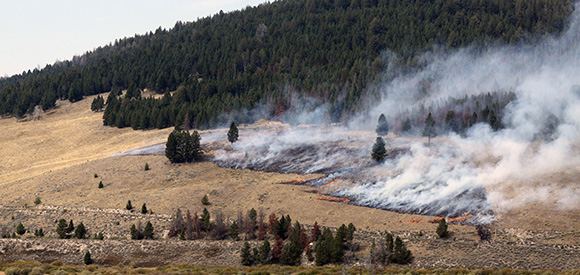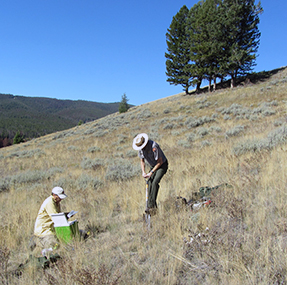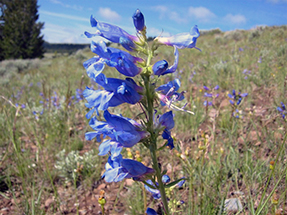“The I&M program wanted to see the effects of fire to the Lemhi penstemon, because fire would most likely reduce competing sage and grass.” Brad Harris, fuels specialist for Glacier National Park


Although maintaining the cultural landscape was the primary goal for a prescribed fire at Big Hole National Battlefield in Montana in September 2014, the 15-acre burn may be significant for several reasons. The intent of the first broadcast burn at the battlefield since 1997 was to mimic the historic role of fire on the mountain slope while improving the vigor of the native vegetation.
Originally, fire managers planned to burn in the spring, when they could target grasses and sagebrush while taking advantage of the snow above the project area on Battle Mountain to control the burn. That plan changed after Big Hole Superintendent Steve Black brought Fire Ecologist Dennis Divoky together with Ecologist Tom Rodhouse from the Pacific West Region’s Upper Columbia Basin Network Inventory and Monitoring (I&M) Program. Rodhouse was interested in burning to benefit the Lehmi penstemon, a relatively rare native plant that grows in only six areas in southwest Montana. Big Hole’s population is one of the larger remaining populations. It is believed that in the absence of fire on the mountain slope, grass and sage can crowd the sensitive penstemon.

USFS
“The I&M program wanted to see the effects of fire to the Lemhi penstemon, because fire would most likely reduce competing sage and grass,” said Brad Harris, fuels specialist for Glacier National Park’s fire program, which provides fire management support to Big Hole National Battlefield. “They asked if we could burn in the fall when the plant was going into dormancy.” Harris added that the ecologists had surveyed the mountain slope quite extensively for the penstemon. “They wanted us to burn smaller blocks instead of burning the entire 150-acre slope all at once in order to study the results of the initial burn(s)”. The project is now divided into four burn blocks.
On September 13, 2014, conditions and funding aligned for fire managers to ignite the first 15-acre unit on the south end of the mountain slope, known as Howitzer Hill. A replica of the howitzer used in the 1877 battle is positioned just above the burn block. Next year, the plan is to move to the 40-acre unit on the north end of the project while the I&M group studies the results of this first burn. The northern slope is known as the Horse Pasture due to its early use by the Nez Perce, who routinely burned off the slope in late summer.
The prescribed fire was not just an inter-regional effort by the NPS, but also required interagency cooperation. The Beaverhead-Deerlodge National Forest supplied three engine crews and twelve firefighters from the Anaconda Job Corps crew sponsored by the forest. Firefighters placed a pump in the river and plumbed the entire perimeter of the unit. The burn next year will be more challenging, because they will need a helicopter to deliver pumps, tanks, and hose to inaccessible areas of the horse pasture unit.
“It was a great experience for the Anaconda crew to be on a prescribed fire, which was their first,” Harris said. “They were the holding crew responsible for the hose lay up the hill and around three flanks of the burn. I think they learned a lot about management-ignited fire, and they did a good job. We’d like to build on that relationship in the future by continuing to use that crew for the rest of this burn project, as well as for other burn projects at the Battlefield and our other small area park--Grant-Kohrs Ranch National Historic Site.”
Contact: Brad Harris, Glacier National Park Fuels Specialist
Email: e-mail us
Phone: (406) 888-7811
Last updated: December 13, 2016
